Regularly solving AP 10th Class Maths Model Papers Set 2 contributes to the development of problem-solving skills.
AP SSC Maths Model Paper Set 2 with Solutions
Instructions :
- In the duration of 3hours 15 minutes, 15 minutes of time is allotted to read the question paper.
- All answers shall be written in the answer booklet only.
- Question paper consists of 4 Sections and 33 questions.
- Internal choice is available in section – IV only.
- Answers shall be written neatly and legibly.
Section – I
(12 × 1 = 12M)
Note:
- Answer all the questions in one word or phrase.
- Each question carries 1 mark.
Question 1.
If A = {1, 2, 3, 4, 5} B = {4, 5, 6, 7}, then A – B is ?
A) {1, 2, 3}
B) {4, 5}
C) {6, 7}
D) {1, 2, 3, 4, 5}
Solution:
A) {1, 2, 3}
Explanation:
A – B = {1, 2, 3, 4, 5} – {4, 5, 6, 7) = {1, 2, 3}
Question 2.
The number of parallel tangents drawn at the end points of a diameter is ………..
Solution:
2
![]()
Question 3.
When the line of sight is below the horizontal line, then the angle between the line of sight and horizontal line is called ……..
Solution:
Angle of depression
Question 4.
Find the mode of the data : 5, 6, 9, 10, 6, 12, 3, 6, 11, 10, 4, 6, 7.
Solution:
6
Question 5.
Statement ‘p’ : 2, 3, 5, 7, 8, 10, 15 …… are in G.P.
Statement ‘q’ : -1, -3, -5, -7, ……. are in A.P.
A) p’ and ‘q’ both are true
B) ‘p’ and ‘q’ both are false
C) ‘p’ is true ‘q’ is false
D) ‘p’ is false q’ is true
Solution:
D) ‘p’ is false q’ is true
Question 6.
Match the following:

Choose the correct answer.
A) a-i, b-ii, c-iii
B) a – ii, b – iii, c – i
C) a – iii, b – i, c – ii
D) a – iii, b – ii, c – i
Solution:
C) a – iii, b – i, c – ii
Question 7.
What is the last digit of 62023 ?
Solution:
6
Question 8.
Write the general form of a linear equation in two variables.
Solution:
ax + by + c = 0 (a2 + b2, ≠ 0)
Question 9.
If θ is the angle made by the line with X-axis in positive direction, the slope m = ………
A) Sin θ
B) Cos θ
C) Tan θ
D) Sec θ
Solution:
C) Tan θ
Question 10.
Pythagorean triplets are the sides of a …….
A) acute angled triangle
B) right angled triangle
C) obtuse angled triangle
D) All of these
Answer:
B) right angled triangle
![]()
Question 11.
Write the equation with roots \(\frac{1}{\alpha}\) and \(\frac{1}{\beta}\)?
Solution:
cx2 + bx + a = 0
Question 12.
The graph of y = p(x) is given in the adjacent figure, then the number of zeroes of p (x) is…….

A) 0
B) 1
C) 2
D) 3
Solution:
D) 3
SECTION – II
(8 × 2 = 16 M)
Note:
- Answer all the questions.
- Each question carries 2 marks.
Question 13.
Find the value of Log232.
Solution:
Let log2 32 be x ⇒ log2 32 = x
2x = 32
2x = 25
∴ x = 5
∴ log232 = 5
Question 14.
Find the midpoint of the line segment joining the points (2, 7) and (12, – 7).
Solution:
The midpoint of the line segment joining the points (2, 7) and (12, -7) is
= \(\left(\frac{x_1+x_2}{2}, \frac{y_1+y_2}{2}\right)\) = \(\left(\frac{2+12}{2}, \frac{7+(-7)}{2}\right)\)
= \(\left(\frac{16}{2}, \frac{0}{2}\right)\) = (8, 0)
Question 15.
A ladder 5 m. long reaches a window of building 4 m. above the ground. Determine the distance of the foot of the ladder from the building.
Solution:
Length of a ladder = AC = 5 m
Height of a window = AB = 4 m
Let the distance of the foot of the ladder from the building = BC = x m
From ∆ABC, ∠B = 90°
By Pythagores theorem;
52 = 42 + x2
25 = 16 + x2
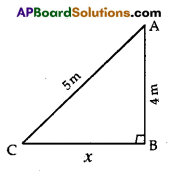
x2 = 25 – 16
x2 = 9
x = \(\sqrt{9}\) = 3 m
The distance of the foot of the ladder from the building = 3 m.
Question 16.
Evaluate

Solution:
cosec 55° cosec (90° – 35°) = sec 35°
[∵ cosec (90° – θ) = sec θ]
∴

= \(\frac{\sec 35^{\circ}}{\sec 35^{\circ}}\) = 1
Question 17.
Can \(\frac{3}{2}\) be the probability of an event? Explain.
Solution:
No, \(\frac{3}{2}\) cant be the probability of an event.
The probability of an event is always lies between 0 and 1
i.e 0 ≤ P(E) ≤ 1
But \(\frac{3}{2}\) = 1.5, it is not lies between 0 and 1
Question 18.
In G. P. an = arn-1. Explain the terms ‘a’ and ‘r’.
Solution:
In G.P. an = a.rn-1
a = first term of G.P
r = common ratio
n = number of terms of G.P
Question 19.
Find the value of ‘k’ for which the pair of equations 2x – ky + 3 = 0, 4x + 6y – 5 = 0 represent parallel lines.
Solution:
Given pair of equations
2x – ky + 3 = 0 and 4x + 6y – 5 = 0
a1 = 2 ; b1 = -k ; c1 = 3;
a2 = 4 ; b2 = 6 ; c2 = -5
Given the pair of lines are parallel
∴ \(\frac{a_1}{a_2}\) = \(\frac{b_1}{b_2}\) ≠ \(\frac{c_1}{c_2}\) ; \(\frac{a_1}{a_2}\) = \(\frac{b_1}{b_2}\) ⇒ \(\frac{2}{4}\) \(\frac{-k}{6}\)
⇒ -4k = 2 × 6 ⇒ -4k = 12 ⇒ k = \(\frac{12}{-4}\) = -3
![]()
Question 20.
From the given figure, find A U B and A ∩ B
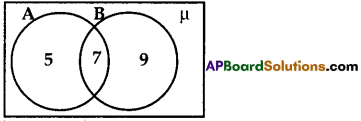
Solution:
From venn diagram
A ∪ B = {5, 6, 7, 8, 9, 10}; A ∩ B = {7, 8}
Section – III
(8 × 4 = 32 M)
Note:
- Answer all the questions.
- Each question carries 4 marks.
Question 21.
Find a quadratic polynomial whose zeroes are 2 and –\(\frac{1}{3}\).
Solution:
Let the quadratic polynomial be ax2 + bx + c, a ≠ 0 and its be α and β. Here α = 2, β = \(\frac{-1}{3}\)
Sum of the zeroes = (α + β)
= 2 + \(\left(\frac{-1}{3}\right)\) = \(\frac{5}{3}\)
Product of the zeroes = (αβ)
= \(2\left(\frac{-1}{3}\right)\) = \(\frac{-2}{3}\)
Therefore the quadratic polynomial
ax2 + bx + c is k[x2 – (α + β)x + αβ], where k is a constant = k[x2 – \(\frac{5}{3}\)x – \(\frac{2}{3}\)]
We can put different values of k.
When k = 3, the quadratic polynomial will be 3x2 – 5x – 2.
Question 22.
Which term of the A, P.: 3, 8, 13, 18, ……. is 78?
Solution:
Here a = 3; d = 8 – 3 = 5 and if an = 78 we have to find n.
We have an = a + (n – 1)d
78 = 3 + (n – 1)5
78 = 3 + 5n – 5
78 = 5n – 2
5n = 78 + 2
5n = 80
n = \(\frac{80}{5}\) = 16
Therefore the 16th term of the given AP is 78.
Question 23.
A bag contains lemon flavoured candies only. Malini takes out one candy without looking into the bag. What is the proba-bility that she takes out
(i) an orange flavoured candy?
(ii) a lemon flavoured candy?
Solution:
The bag contains only lemon flavoured candies.
i) So, the event that Malini takes an orange flavoured candy is an Impossible event. So, the corresponding probability is zero.
ii) The event that Malini takes a lemon flavoured candy is certain event. So, the corresponding probability is 1.
Question 24.
State the reasons for the following :
i) {1, 2, 3, ……, 10} ≠ {x : x ∈ N and 1< x < 10} ii) {2, 4 > 6, 8, 10} ≠ {x : x = 2n + 1 and n ∈ N]
iii) {5, 15, 30, 45} ≠ {x : x is a multiple of 15}
iv) {2, 3, 5, 7, 9} ≠ {x : x is a prime number}
Solution:
i) {1, 2, 3, ……., 10) ≠ {2, 3, 4, 5, 6, 7, 8, 9}
In LHS set contains 1 and 10 are elements but in RHS they are not the elements of that set.
ii) {2, 4, 6, 8, 10} ≠ {x : x = 2n + 1 and x ∈ N)
{2, 4, 6, 8, 10} ≠ {3, 5, 7, 9 ……….}
LHS is a set of even numbers less than 10. It is a finite set.
But RHS is a set of odd numbers. It is an infinite set.
iii) {15, 15, 30, 45) ≠ {x : x is a multiple of 15}
5 is not a multiple of 15.
iv) {2, 3, 5, 7,9) ≠ {x : x is a prime number}
9 is not a prime number.
Question 25.
Prove that

Solution:
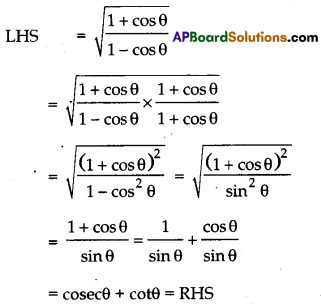
Question 26.
Write the formula to find the median of the grouped data and explain its terms.
Solution:
Median = l + \(\frac{\frac{n}{2}-c f}{f}\) × h
Where l = lower limit of the median class.
h = length of the median class.
f = frequency of the median class.
cf = cumulative frequency of the class preceeding the median class.
Question 27.
Calculate the length of a tangent from a point 15 cm away from the centre of a circle of radius 9 cm.
Solution:
It is given that radius (r) = 9 cm
OQ(d) = 15 cm
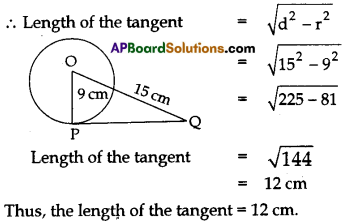
Question 28.
Find the roots of
(i) \(\frac{1}{x+4}\) – \(\frac{1}{x-7}\) = \(\frac{11}{30}\); x ≠ -4, 7
Solution:

which is a quadratic equation.
Here a = 1 ; b = -3; c = 2;
So, b2 – 4ac = (-3)2 – 4(1)(2)
= 9 – 8 = 1 > 0
Therefore x = \(\frac{-(-3) \pm \sqrt{1}}{2 \times 1}\) = \(\frac{3 \pm 1}{2}\)
x = \(\frac{3+1}{2}\) = \(\frac{4}{2}\) = 2
x = \(\frac{3-1}{2}\) = \(\frac{2}{2}\) = 1
∴ The roots are 1, 2
Section – IV
(5 × 8 = 40 M)
Note:
- Answer all the questions,
- Each question carries 8 marks,
- Each question has internal choice.
Question 29.
a) If (2.3)x = (0.23)y = 1000, then find the value of \(\frac{1}{x}\) – \(\frac{1}{y}\)
(OR)
b) If A = {X : X is a natural number}
B = {X : X is an even natural number}
C = {X : X is a odd natural number) and
D = {X : X is a prime number}
Find:
i) A ∪ B
ii) A – C
iii) A – D
iv) B ∪ C
Solution:
a) (2.3)x = (0.23)y = 1000
(2.3)x = 1000;
(2.3)x = 103
2.3 = \(10^{\frac{3}{x}}\);
2.3 = \(10^{\frac{3}{x}}\);
2.3 = \(10^{\frac{3}{x}}\);
(0.23)y = 1000
(0.23)y = 103
0.23 = \(10^{\frac{3}{y}}\)
\(\frac{2.3}{10}\) = \(10^{\frac{3}{y}}\)
2.3 = \(10^{\frac{3}{y}}\) × 101
= \(10^{\frac{3}{y}+1}\)
∴ \(10^{\frac{3}{x}}\) = \(10^{\frac{3}{\mathrm{y}}+1}\)
\(\frac{3}{x}\) = \(\frac{3}{y}\) + 1
3(\(\frac{3}{x}\)) = 3(\(\frac{1}{y}\) + \(\frac{1}{3}\))
\(\frac{1}{x}\) = \(\frac{1}{y}\) + \(\frac{1}{3}\)
∴ \(\frac{1}{x}\) – \(\frac{1}{y}\) = \(\frac{1}{3}\)
b)
A {x : x is a natural number}
= {1, 2, 3, 4, 5, 6, 7, 8……..}
B = {x : x is an even natural number}
= {2, 4, 6, 8…….}
C = {x : x is an odd natural number)
= {1, 3, 5, 7,…….. }
D = {x : x is a prime number)
= {2, 3, 5, 7,……..}
i) A ∩ B
{1, 2, 3, 4, 5, 6, 7, 8……} ∩ {2, 4, 6, 8…….}
= {2, 4, 6, 8……. }
= {even natural numbers)
ii) A – C
A – C = {1, 2, 3, 4, 5, 6, 7, 8……} – {1, 3, 5, 7…….}
= {2, 4, 6, 8………..}
= (even natural numbers)
iii) A – D
= {1, 2, 3, 4, 5, 6, 7, 8…….} – {2, 3, 5, 7……..}
= {1, 4, 6, 8……}
iv) B ∪ C
B ∪ C = {2, 4, 6, 8……} ∪ {1, 3, 5, 7……}
= {1, 2, 3, 4, 5, 6, 7, 8…..}
= {natural numbers}
![]()
Question 30.
a) Solve the equations by reducing them to a pair of linear equations. \(\frac{1}{3 x+y}\) + \(\frac{1}{3 x-y}\) = \(\frac{3}{4}\)
\(\frac{1}{2(3 x+y)}\) + \(\frac{1}{2(3 x-y)}\) = \(\frac{-1}{8}\)
(OR)
b) One card is drawn from a well shuffled deck of 52 cards. Find the probability of getting:
i) a king of red colour
ii) a queen of diamonds
iii) a jack of spade
iv) a black face card
Solution:
a) \(\frac{1}{3 x+y}\) + \(\frac{1}{3 x-y}\) = \(\frac{3}{4}\) …….. (1)
\(\frac{1}{2}\left(\frac{1}{3 x+y}\right)\) – \(\frac{1}{2}\left(\frac{1}{3 x-y}\right)\) = \(\frac{-1}{8}\) …… (2)
If we substitute \(\frac{1}{3 x+y}\) = p and \(\frac{1}{3 x-y}\) = p we get a pair of linear equations:
p + q = \(\frac{3}{4}\) ⇒ 4p + 4q = 3 …….. (3)
\(\frac{1}{2}\)p – \(\frac{1}{2}\)q = \(\frac{-1}{8}\) ⇒ 4p – 4q = -1 …….. (4)
Elimination Method:
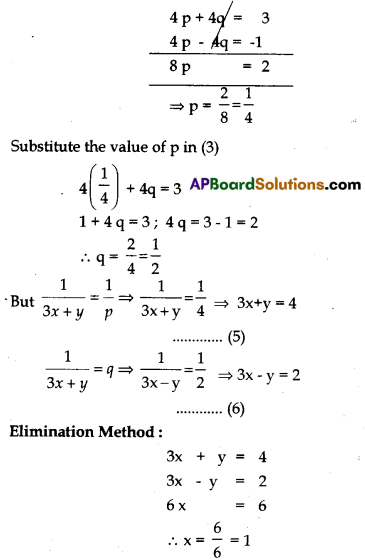
Substitute the value of x in (5)
3(1) + y = 4
3 + y = 4
∴ y = 4 – 3 = 1
∴ x = 1 ; y = 1
b) Total number of cards in a deck = 52
Total possible outcomes =52
i) A king of red colour
Let E be the event of getting a king of red colour
Number of favourable outcomes to event
(E) = 2
Probability of an event P(E)
\(=\frac{\text { No. of favourable outcomes }}{\text { Total possible outcomes }}\)
= \(\frac{2}{52}\) = \(\frac{1}{26}\)
ii) A queen of diamonds.
Let ‘F’ be the event of getting a queen of diamonds
Number of favourable outcomes to event F = 1
Probability of an event p(F) = \(\frac{1}{52}\)
iii) A jack of spade
Let ‘G’ be the event of getting a jack of spade.
Number of favourable outcomes to event G = 1
Probability of an event P(G) = \(\frac{1}{52}\)
iv) A black face card.
Let ‘H be the event of getting a black face card.
Number of favourable outcomes to getting event
H = 6
Probability of an event G = P(H) = \(\frac{6}{52}\)
= \(\frac{3}{26}\)
Question 31.
a) Show that the points (1, 7), (4, 2), (-1, -1) and (-4, 4) are the vertices of a square.
(OR)
b) An iron pillar consists of a cylindrical portion of 2.8 m. height and 20 cm. in diameter and a cone of 42 cm. height surmounting it. Find the weight of the pillar if 1 cm3 of iron weighs 7.5 g.
Solution:
a) Let A (1, 7), B(4, 2), C(-1, -1) and D (-4, 4) be the given points.
One way of showing that ABCD is a square is to use the property that all its sides should be equal and both its digonals should also be equal. Now
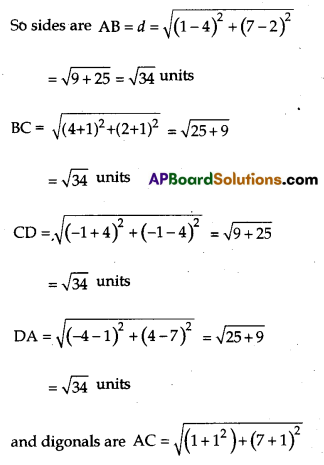
= \(\sqrt{4+64}\) = \(\sqrt{68}\) units
BD = \(\sqrt{(4+4)^2+(2-4)^2}\) = \(\sqrt{64+4}\) = \(\sqrt{68}\) units
Since AB = BC = CD = DA and AC = BD. So all the four sides of the quadrilateral ABCD are equal and its diagonals AC and BD are also equal.
Therefore, ABCD is square.
b) Height of the cylinder portion = 2.8 m = 280 cm
Diameter of the cylinder = 20 cm
Radius of the cylinder = \(\frac{20}{2}\) cm = 10 cm
Volume of the cylinder = πr2h
= \(\frac{22}{7}\) × 10 × 10 × 280 cm3
= 88000 cm3
Height of the cone (h) = 42 cm
Radius of the cone (r) = 10 cm
Volume of the cone (v) = \(\frac{1}{3}\)πr2h
= \(\frac{1}{3}\) × \(\frac{22}{7}\) × 10 × 10 × 42 cm3 = 4400 cm3
Volume of the pillar
= 88000 cm3 + 4400 cm3
= 92400 cm3
Weight of 1 cm3 of iron = 7.5 g
Weight of the pillar = 7.5 × 92400 g
= 693000 g
= 693 kg
Question 32.
a) A tree breaks due to storm and the broken part bends so that the top of the tree touches the ground by making 300 angle with the ground. The distance between the foot of the tree and the top of the tree on the ground is 6 m. Find the height of the tree before falling down.
(OR)
b) The following data gives the information on the observed life time (in hours) of 225 electrical components.
| Life times (in hrs) |
0-20 | 20-40 | 40-60 | 60-80 | 80-100 | 100-120 |
| Frequency | 10 | 35 | 52 | 61 | 38 | 29 |
Determine the modal life time of the components.
Solution:
a) Let Initial height of tree be AD when storm come, the tree which is broken at B and top touches the
ground at C.
∴ height of tree = AB + BC
AC = 6 m
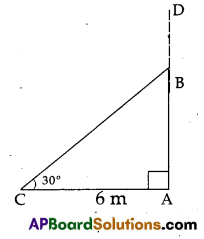
In ∆ABC, ∠A = 90°, ∠C = 30°
tan C = tan 30° = \(\frac{1}{\sqrt{3}}\)

b) 61 is the highest frequency corresponding to the class interval 60 – 80.
So, modal class : 60-80
l = lower limit of the modal class = 60
f1 = frequency of the modal class = 61
h = modal class length = 20
f0 = frequency of the preceeding class to 60 – 80 = 52
f2 = frequency of the suceeding class to 60 – 80 = 38
f1 – f0 = 61 – 52 = 9
2f1 – f0 – f2 = 2 × 61 – 52 – 38 = 122 – 90 = 32
So,

Therefore more electrical components have life time of 65.625 hours.
![]()
Question 33.
a) Draw the graph of the polynomial p(x) = x2 – x – 12 and find the zeroes.
(OR)
b) Construct a triangle of sides 4 cm, 5 cm and 6 cm. Then, construct a triangle similar to it, whose sides are \(\frac{2}{3}\) of the corresponding sides of the first triangle.
Solution:
a) p(x) = x2 – x – 12; y = x2 – x – 12


-3 and 4 are zeroes of the quadratic polynomial because (-3, 0) and (4, 0) are intersection points of X axis.
Justification:
x2 – x – 120 ⇒ x2 – 4x + 3x – 12.
0 ⇒ (x – 4) (x + 3) = 0
x – 4 = 0 and x + 3 = 0
x = 4, x = -3 zeroes of p(x) = -3, 4.
b)
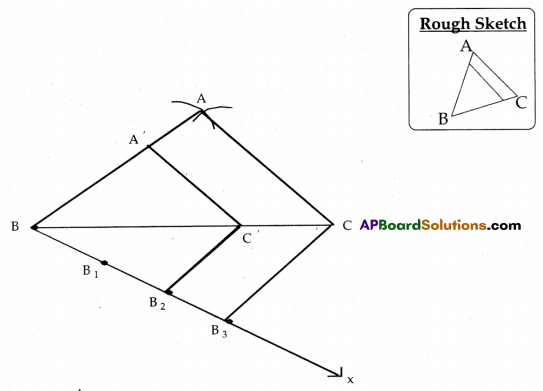
Steps of construction:
- Construct a triangle ABC with sides 4 cm, 5 cm and 6 cm.
- Draw a ray BX, making an acute angle with BC on the side opposite to vertex A.
- Locate 3 points B1, B2, B3 on BX so that BB1 = B1B2 = B2B3.
- Join B3C and draw a line from B2 to C which is parallel to B3C and it is intersecting BC at C.
- Draw a line through C parallel to AC to intersect AB at A’
So, ∆A’BC’ is the required triangle.